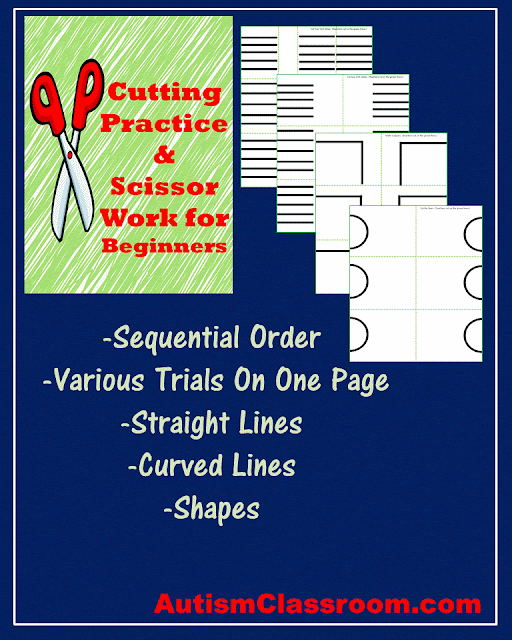Early this week, I wrote about fine motor skills related to writing. We also know that our students sometimes have trouble with cutting and scissor skills. Obviously, first, we have to teach scissor safety so that kids are not endangering themselves and others. For some students, this may mean that you stay close to them at all times when using scissors. For others, it may mean starting with plastic safety scissors. Still others might simply need to know what to with the scissors and they can take it form there.
When I work with students to increase scissor skills, I use a variety of scissor types. For example, for students who really have safety as an issue, I might use an "ultra safe" kids scissors product. For students who can close the scissors, but might have a hard time opening then, I might use an "easy spring" scissor product because it automatically springs back into action. Additionally, I like the scissors that allow for all four of the students fingers to go in the bottom hole and the thumb at the top so that they have somewhere to place their fingers while cutting. And.......I cannot say enough about the combo pair with all of these innovations in one!
Teaching Scissor Skills
Once you have decided what tool to use, it is time to begin teaching the skill. First, assess what the student already knows about cutting paper. Some kids know to place the scissors up to the paper and some do not. After you get your starting point, teach that skill. For many starting out, the first step is to make small snips in paper. These can be without lines for the student to cut specifically or you could give them a visual cue of where to cut. If paper is to flimsy, try an index card for making snips in paper.
The resource called Cutting Practice and Scissor Work for Beginners provides handouts with sequenced steps for scissor work.
Most pages contain several trials of the skill on one page.
The resource also includes lines, curves, and shapes.
 Click for More Information
Click for More Information
The steps to cutting the square is broken down into parts. First, the student will need to cut a straight line to "cut a square" shape. You set it up so that after they finish, they have a square. Next, you provide them with just an L shaped line, so that after they cut the L-shaped line, they have a square. Third, you give them a square with 3 lines to cut. After they have mastered all of these, you can give them the full square to cut. For some students, this task is easier if you use card stock paper which is not as flimsy as regular copy paper.

The steps to cutting the square is broken down into parts. First, the student will need to cut a straight line to "cut a square" shape. You set it up so that after they finish, they have a square. Next, you provide them with just an L shaped line, so that after they cut the L-shaped line, they have a square. Third, you give them a square with 3 lines to cut. After they have mastered all of these, you can give them the full square to cut. For some students, this task is easier if you use card stock paper which is not as flimsy as regular copy paper.
If you need to teach this skill, give these tips a try. Bring lots of patience. Have fun!






No comments :
Post a Comment